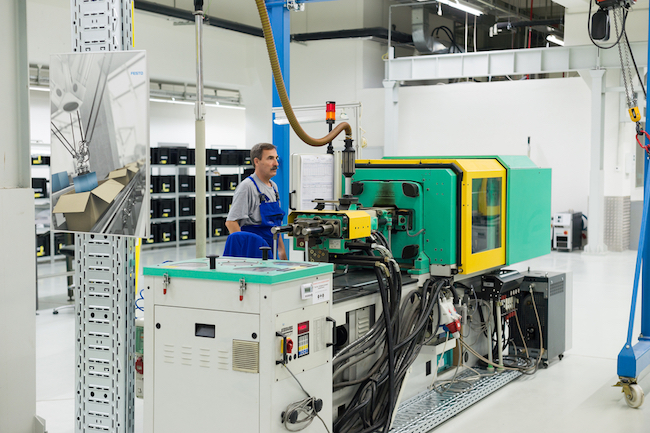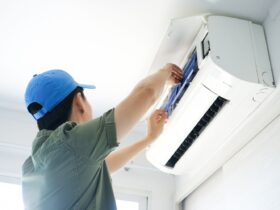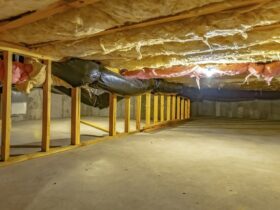Commercial pressure washing is a highly effective and efficient method for cleaning various surfaces, such as buildings, parking lots, sidewalks, and more. It utilizes the power of high-pressure water to remove dirt, grime, mold, mildew, and other contaminants. In this comprehensive guide, we will explore the four essential steps involved in commercial pressure washing, along with the benefits and considerations associated with this cleaning method.
Introduction to Commercial Pressure Washing
Commercial pressure washing is a cleaning method that utilizes high-pressure water to remove dirt, grime, mold, mildew, and other contaminants from various surfaces. It is commonly used for cleaning commercial buildings, parking lots, sidewalks, driveways, and other exterior surfaces. The high-pressure water stream created by a pressure washer effectively blasts away stubborn stains and debris, leaving surfaces clean and revitalized.
Commercial pressure washing offers numerous benefits, including enhanced curb appeal, increased longevity of surfaces, and improved safety and hygiene. However, it is essential to follow the proper steps and considerations to ensure effective and safe cleaning. In the following sections, we will delve into the four key steps involved in commercial pressure washing, providing detailed guidance for each stage of the process.
Step 1: Preparing for the Pressure Washing Job
Before starting the pressure washing job, proper preparation is crucial to ensure a smooth and efficient cleaning process. This step involves inspecting the surface, clearing the area, and gathering the necessary equipment and supplies.
Inspecting the Surface
Before beginning the pressure washing job, it is essential to inspect the surface to be cleaned. This inspection allows you to identify any potential issues or areas that may require special attention. Look for cracks, loose paint, damaged surfaces, or delicate areas that may be susceptible to damage from the high-pressure water stream. By identifying these areas beforehand, you can take the necessary precautions to avoid causing further damage during the cleaning process.
Clearing the Area
Clearing the area to be pressure washed is another critical step in preparation. Remove any obstacles, such as furniture, vehicles, or debris, that may hinder the cleaning process. Clearing the area ensures that the pressure washer has unobstructed access to the surfaces to be cleaned, allowing for thorough and efficient cleaning.
Gathering the Necessary Equipment and Supplies
Before starting the pressure washing job, gather all the necessary equipment and supplies. The primary equipment needed for commercial pressure washing includes a pressure washer, various nozzles or tips, hoses, and safety gear such as goggles and gloves. Additionally, depending on the specific cleaning requirements, you may need detergents or cleaning solutions designed for use with pressure washers. Ensure that you have all the required equipment and supplies readily available to avoid interruptions during the cleaning process.
Step 2: Applying Detergent or Cleaning Solution
Once the surface has been inspected, cleared, and the necessary equipment and supplies have been gathered, it is time to apply the detergent or cleaning solution. This step is crucial for effectively removing stubborn stains, dirt, and contaminants from the surface.
Choosing the Right Detergent
When selecting a detergent or cleaning solution for pressure washing, it is essential to choose one that is suitable for the surface being cleaned and the type of stains or contaminants present. Different surfaces and stains may require specific detergents or cleaning solutions to achieve optimal results. Consult the manufacturer’s instructions or seek professional advice to ensure you are using the appropriate detergent or cleaning solution for the job.
Diluting the Detergent
In most cases, detergents or cleaning solutions used in pressure washing need to be diluted with water before application. Follow the manufacturer’s instructions regarding the appropriate dilution ratio. Proper dilution ensures that the detergent is effective in removing stains and contaminants without causing damage to the surface.
Applying the Detergent to the Surface
Once the detergent or cleaning solution has been properly diluted, it can be applied to the surface using a pressure washer. Attach the appropriate nozzle or tip to the pressure washer wand, specifically designed for detergent application. Begin by applying the detergent from the bottom and work your way up, ensuring thorough coverage of the surface. Allow the detergent to dwell for the recommended period, typically a few minutes, to allow it to loosen dirt and stains effectively.
Step 3: Pressure Washing the Surface
After the detergent has had time to dwell on the surface, it is time to proceed with the pressure washing. This step involves adjusting the pressure washer settings, using proper techniques, and cleaning different types of surfaces.
Adjusting the Pressure Washer Settings
Before starting the pressure washing process, it is important to adjust the pressure washer settings according to the surface to be cleaned. Different surfaces and stains require varying levels of pressure for optimal cleaning. Adjust the pressure washer’s PSI (pounds per square inch) and GPM (gallons per minute) settings to ensure effective cleaning without causing damage to the surface.
Using Proper Techniques for Pressure Washing
When pressure washing, it is crucial to use proper techniques to achieve the best results and prevent damage. Hold the pressure washer wand at a consistent distance from the surface, typically around 12-24 inches, depending on the surface and the pressure washer’s power. Move the wand in a sweeping motion, overlapping each pass to ensure thorough cleaning. Avoid staying in one spot for too long, as this can cause damage to the surface.
Cleaning Different Types of Surfaces
Different types of surfaces require specific considerations when pressure washing. For example, concrete surfaces can withstand higher pressure, while more delicate surfaces like wood or painted surfaces may require lower pressure to avoid damage. Adjust the pressure washer settings accordingly and test a small inconspicuous area before proceeding with pressure washing the entire surface. Take extra care when pressure washing windows or fragile surfaces to prevent breakage or damage.
Step 4: Post-Pressure Washing Cleanup
Once the pressure washing process is complete, there are several essential steps to ensure a clean and well-maintained surface. This includes rinsing the surface, removing excess water and residue, and inspecting the cleaned surface.
Rinsing the Surface
After pressure washing, it is crucial to thoroughly rinse the surface to remove any remaining detergent, debris, or contaminants. Use a wide-angle or rinsing nozzle attachment on the pressure washer to cover a larger area and ensure even rinsing. Start at the top and work your way down, ensuring that all areas are adequately rinsed.
Removing Excess Water and Residue
Once the surface has been rinsed, remove any excess water or residue to prevent water spots or streaks. Use a squeegee or a soft-bristle brush to remove excess water, working from top to bottom. Pay attention to corners, edges, and crevices where water may accumulate. Additionally, if there are areas with stubborn stains or residue, you may need to repeat the pressure washing process or use targeted cleaning methods.
Inspecting the Cleaned Surface
After the surface has been rinsed and excess water removed, take the time to inspect the cleaned surface. Ensure that all stains, dirt, and contaminants have been effectively removed. If there are any areas that require further attention, you can spot treat them or repeat the pressure washing process. Proper inspection ensures that the surface is thoroughly cleaned and ready for use.
Benefits of Commercial Pressure Washing
Commercial pressure washing offers numerous benefits for businesses and property owners. Understanding these benefits can help you make an informed decision regarding the maintenance and cleaning of your commercial property. Here are some key benefits of commercial pressure washing:
Enhanced Curb Appeal
Regular pressure washing can significantly enhance the curb appeal of your commercial property. It removes dirt, grime, and stains, making surfaces look clean and well-maintained. A clean and attractive exterior creates a positive impression on customers, clients, and visitors, contributing to a professional and inviting image for your business.
Increased Longevity of Surfaces
By regularly pressure washing your commercial property, you can extend the longevity of various surfaces. The removal of dirt, mold, and other contaminants prevents them from causing damage or degradation over time. Pressure washing can help prevent premature wear, rot, or deterioration, saving you money on repairs or replacements in the long run.
Improved Safety and Hygiene
Pressure washing not only improves the appearance of surfaces but also enhances safety and hygiene. By removing slippery substances like algae or mold, pressure washing reduces the risk of slips and falls, creating a safer environment for employees, customers, and visitors. Additionally, pressure washing helps eliminate bacteria, allergens, and other harmful substances, promoting a cleaner and healthier space.
Considerations for Commercial Pressure Washing
While commercial pressure washing offers numerous benefits, there are several considerations to keep in mind to ensure safe and effective cleaning. These considerations include the environmental impact, safety precautions, and the choice between hiring a professional or DIY.
Environmental Impact
Pressure washing involves the use of water and, in some cases, detergents or cleaning solutions. It is important to consider the environmental impact of these substances and take measures to minimize any negative effects. Use biodegradable and eco-friendly detergents whenever possible and follow local regulations regarding the disposal of wastewater.
Safety Precautions
Pressure washing can be potentially dangerous if not done correctly. It is crucial to follow safety precautions, such as wearing appropriate protective gear, including goggles, gloves, and non-slip footwear. Additionally, be cautious of electrical hazards when using pressure washers and ensure proper grounding and electrical safety measures are in place.
Hiring a Professional vs. DIY
While DIY pressure washing may seem like a cost-effective option, hiring a professional pressure washing service has several advantages. Professionals have the expertise, experience, and specialized equipment to handle different surfaces and stains effectively. They can ensure optimal results while minimizing the risk of damage to the property or personal injury. Consider the scope of the job, your experience, and the desired outcome when deciding between DIY and professional pressure washing.
Conclusion
Commercial pressure washing is a highly effective method for cleaning various surfaces, providing numerous benefits for businesses and property owners. By following the four essential steps of preparing, applying detergent, pressure washing, and post-cleanup, you can achieve clean and revitalized surfaces. Consider the benefits and considerations associated with commercial pressure washing to make informed decisions regarding the maintenance and cleaning of your commercial property. Whether you choose to hire a professional or tackle the job yourself, regular pressure washing can help enhance curb appeal, increase the longevity of surfaces, and promote a safer and healthier environment.





